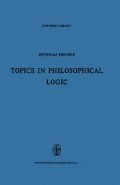Abstract
The purpose of this chapter is to present a very versatile family of logical systems of positional or topological logic. These systems — obtained by generalizing the existing systems of chronological logic — are to have a very general nature, capable of reflecting the characteristics of a wide range of logical systems, including not only chronological (also temporal or tense) logic, but also what we may call locative or place logic, and even a logic of ‘possible worlds’.
Access this chapter
Tax calculation will be finalised at checkout
Purchases are for personal use only
Preview
Unable to display preview. Download preview PDF.
References
The proof of the interdeducibility of (R) and (RS) is as follows:
We shall write numerical parameter-values as subscripts.
Given the weaker thesiswe may now prove the stronger
See N. Rescher and J. Garson, `A Note on Chronological Logic’, Theoria 33 (1967) 39–44. The system which is shown equivalent to von Wright’s T-calculus is the chronological analogue of a topological system consisting of (PI), (P2), (P4), and (P5.2); a system which may be designated as PoII, i.e., PII minus axiom (P3).
The converse of (A3.2): p Rn (p) isovable for n =0 in P2 and the two theses: p = Rn(p) and (A4): (Vt) Re(p) p are interdeducible in these systems.
This observation is based on an idea developed by Alan Rose in his paper, `Eight Valued Geometry’ in the Proceedings of the London Mathematical Society 3 (1952) 30–44.
We assume that each system is such that for every formula either it or its negation is true in that system. This guarantees that ’’P (p) P (gyp).
We wish to thank Professor Nuel D. Belnap, Jr. for assistance in establishing this fact. (For the modal systems now at issue see p. 285 below.)
It could even be assumed that x y is not defined everywhere; otherwise the special stipulation laid down in connection with S4, viz., (Ix) (dy) (3z) (x Q y = z),would become superfluous.
This chapter is an almost unrevised version of an article of the same title written collaboratively with James Garson and published in The Journal of Symbolic Logic 33 (1968).
Rights and permissions
Copyright information
© 1968 Springer Science+Business Media Dordrecht
About this chapter
Cite this chapter
Rescher, N. (1968). Topological Logic. In: Topics in Philosophical Logic. Synthese Library, vol 17. Springer, Dordrecht. https://doi.org/10.1007/978-94-017-3546-9_13
Download citation
DOI: https://doi.org/10.1007/978-94-017-3546-9_13
Publisher Name: Springer, Dordrecht
Print ISBN: 978-90-481-8331-9
Online ISBN: 978-94-017-3546-9
eBook Packages: Springer Book Archive

